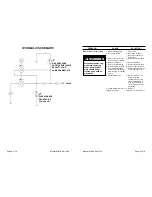
Manual M-800 Rev. 6/09
Manual M-800 Rev. 6/09
Pump
• Do not exceed the PSI hydraulic pressure rating noted on the pump
nameplate or tamper with the internal high pressure relief valve.
Creating pressure beyond rated capacities can result in personal injury.
• Before replenishing the oil level, retract the system to prevent overfilling
the pump reservoir. An overfill can cause personal injury due to excess
reservoir pressure created when cylinders are retracted.
Cylinder
• Do not exceed rated capacities of the cylinders. Excess pressure can
result in personal injury.
• Do not set poorly-balanced or off-center loads on a cylinder. The load
can tip and cause personal injury.
Power Supply (Electric)
• IMPORTANT: In order to meet certain
electrical safety requirements, pumps in
this series wired for 115 Volt AC 60 Hz
are required to contain a 20 AMP plug
as shown to the right. Plug unit into the
appropriate 20 AMP electrical female
receptacle. Do not modify the pump
power cord or plug in any way - doing so
will VOID the product warranty on any
electrical components.
• Do not use an ungrounded (two-prong) extension cord with this unit.
• Avoid any conditions that could create an electrical hazard.
• Any electrical work must be done by a qualified electrician.
• If the power cord is damaged or wiring is exposed, replace or repair
immediately.
• Disconnect the power supply before removing the motor control box
cover or performing repairs or maintenance.
• Pump must be plugged into corresponding voltage power source.
• Branch circuit must be sized properly for proper operation of pump. For
best performance, plug pump into a circuit rated equal to or greater than
the maximum amp rating or pump.
• If branch circuit breaker or fuse opens continuously, do not attempt to
increase the power line capacity by replacing a fuse or breaker with
another of higher value. Overheating of the power line and possibility of
a fire will result.
WARNING (cont’d)
!
Page 2 of 16
Page 15 of 16
Section 8. Exposure Control / Personal Protec-
tion
Engineering Controls: For normal application,
special ventilation is not necessary. If user’s
operations generate vapors or mists, use ventila-
tion to keep contaminants below exposure limits.
Make-up air should always be supplied to balance
air removed by exhaust. Have eyewash station and
safety-shower close to workstation.
Personal Protection:
Eyes: Eye protection should be determined based
on conditions of use. If product is used in applica-
tion where splashing may occur, the use of safety
goggles and/or a face shield should be considered.
Hands and Body: Wear appropriate chemically
protective gloves and wear appropriate clothing to
prevent skin contact.
Respiratory: NIOSH approved respirators should
be used when airborne contamination is above
exposure limits.
Feet: Wear appropriate footwear to prevent product
from coming in contact with feet and skin.
Section 9. Physical and Chemical Properties
Appearance, Physical State: Clear, Blue, Viscous
Liquid
Odor: Mild petroleum
Viscosity: 41.4 - 50.6 cSt @40 deg C
Flash Point: >=200 deg. C (392 deg. F)
Vapor pressure: Negligible at ambient temperature
and pressure
Specific Gravity: 0.875 kg/L @20 deg. C (68 deg.
F)
Water solubility: Insoluble in water
pH: Not applicable
Section 10. Stability and Reactivity
Stability: Stable under normal handling and storage
condition
Hazardous Polymerization: Will not occur at normal
working conditions.
Incompatible Substances / Conditions to Avoid:
Reactive with oxidizing agents and acids.
Decomposition Products: Combustion can yield
carbon, nitrogen, sulfur, phosphorus, and zinc
oxides.
Section 11. Toxicological Information
Routes of entry: Skin and eye contact, inhalation,
ingestion.
Acute Lethality: Based on toxicity of components.
Acute oral toxicity (LD50):>2000 mg/kg rat.
Chronic or Other Toxic Effects.
Derma Route: Prolonged or repeated contact may
cause skin irritation characterized by dermatitis or
oil acne.
Inhalation Route: Negligible breathing hazard at
normal temperature. Elevated temperatures or me-
chanical action may form vapors, mists or fumes.
Material Safety Data Sheet
Material Safety Data Sheet
Page 2
AW Hydraulic Oil ISO 46
Inhalation of oil mists or vapors from hot oil may
cause irritation of the upper respiratory track.
Oral Route: Low toxicity.
Eye Irritation / Inflammation: Repeated or
prolonged contact may cause irritation but not
permanent damage.
Immunotoxicity: Not available.
Skin Sensitization: Not expected to be skin sen-
sitizer.
Respiratory Tract Sensitization: Not expected to be
respiratory tract sensitizers.
Carcinogenicity: This product is not known to con-
tain any chemicals at reportable quantities that are
listed as carcinogens by NTP, IARC, OSHA.
Other Considerations: No additional remark.
Section 12. Ecological Information
Environmental Fate: Not available.
Persistence / Bioaccumulation Potential: Not
available.
BOD5 and COD: Not available.
Product of Biodegradation: Not available.
Additional Remarks: No additional remarks.
Section 13. Disposal Considerations
Waste Disposal: Spent/used waste oil may meet
the requirements of a hazardous waste. Con-
sult your local or regional authorities. Preferred
waste management priorities are: (1) recycle or
reprocess, (2) incinerate with energy recovery, (3)
disposal at licensed waste disposal facility. Ensure
that disposal or reprocessing is in compliance
with government requirements and local disposal
regulations.
Section 14. Transport Information
TDG Classification: Not controlled under TDG
(Canada).
DOT Shipping Description: Not classified as
hazardous.
Special Provisions for Transport: Not applicable
Section 15. Regulatory Information
This product is acceptable for use under the
provisions of WHMIS-CPR. All components of this
formulation are listed on the CEPA-DSL. (Domestic
Substances List).
All components of this formulation are listed on the
US EPA-TSCA Inventory.
This product has been classified in accordance
with the hazard criteria of the Controlled Products
Regulations (CPR) and the MSDS contains all of
the information required by the CPR.
This product is not known to contain any chemicals
at reportable quantities that are listed on the SARA
313 and 40 CFR 372.
This product is not controlled under the HCS.


























